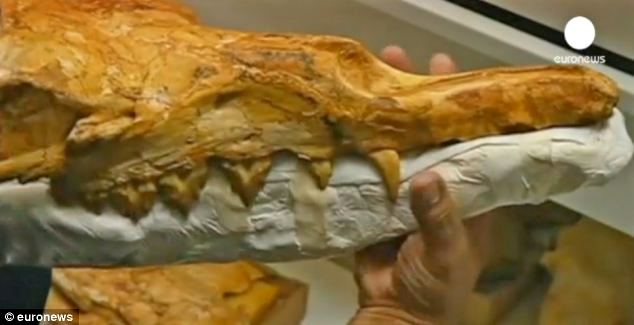Walking Whale’ Fossil Discovered In Peru’s Ocucaje Desert
 |
| Geologist brushes the fossilized jaw of a whale lying on the desert pavement of Ocucaje, 310 km south of Lima |
Paleontologists in Peru have unearthed the fossil of a 40 million-year-old “walking whale.”
Found in the Ocucaje Desert in southern Peru, the fossils belong to a group called Achaeocetes, or ancient whales, that possess both land- and sea-dwelling characteristics. Over time, the ancient land animals adapted to water environments where their legs became fin-like and their bodies began to resemble modern sea mammals like dolphins and whales, ITN reports.
“We already knew about the paleontological richness of Ocucaje dating back 10 million to 12 million years,” paleontologist Rodolfo Salas said about the find. “Now we can say that the most important primitive sea mammal deposit in South America is at Ocucaje.”
The whale’s remains are the oldest ever found in South America; other whale fossils from this time period have been found in Egypt, Pakistan, India and North America, euronews reports. The skull, which resembles that of a wolf or crocodile, may help researchers understand the link between modern whales and their ancestors.
The first whale ancestor was a hairy, four-legged omnivore that evolved into a range of amphibious species 50 million years ago, scientists say. They lost their spine and hind legs 5 million years later.
This marks the second discovery of an ancient whale fossil this year. In August, on the banks of the Potomac River in Virginia, scientists excavated a 15 million-year-old whale skull measuring about six feet long, the Washington Post reports. The skeleton, believed to come from an extinct baleen whale, was a rare find.
 |
| This is the first time that such an old sea mammal has been found in South America |
“To have such a large and complete specimen is pretty uncommon,” John Nance, the paleontology collections manager at the Calvert Marine Museum in Southern Maryland, said. “In a marine environment, the bones are usually scavenged and scattered all about,” he said. “[With this,] the really interesting thing is we have all the postcranial material — the vertebrae, the ribs, the flipper bones. It will give us a more complete picture of what these animals looked like.”
Another standout among the 15 or more ancient whale fossils that have been discovered in the Ocucaje desert was the 3.6 million-year-old remains of a minke whale. “It is a species known only in Peru, paleontologist Cesar Chacaltana told the Daily Mail about the fossil, which weighed about 1,100 pounds and measured 19 feet long. And there are more specimens to be found here, paleontologists believe. “There is probably a greater number of fossils in the sand, but it takes high-tech equipment to locate and recover them,” Chacaltana said.